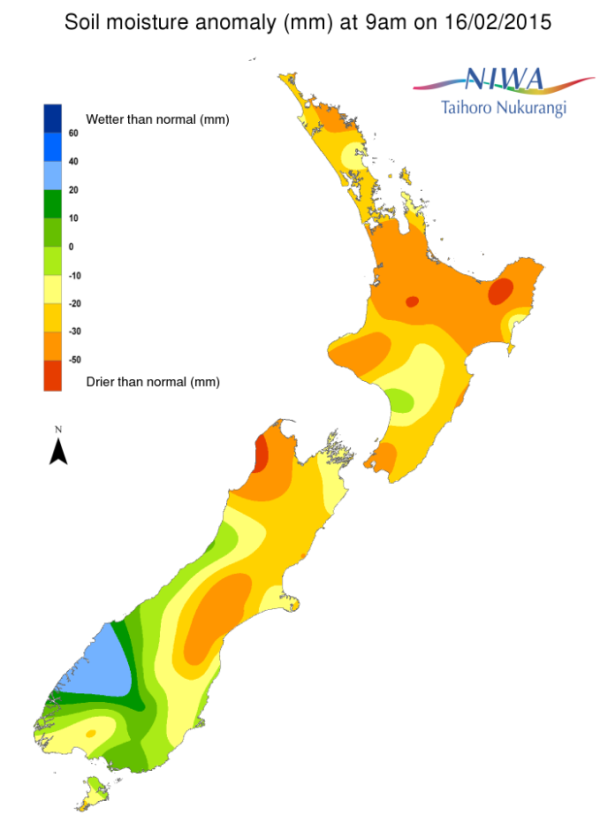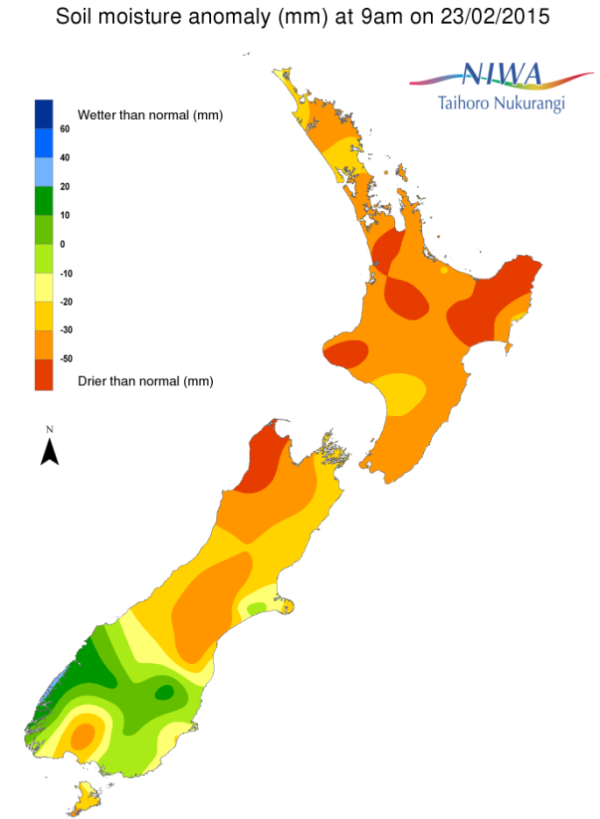Weekly update to help media assess likelihood of extremely dry weather preceding a drought. Regions experiencing severely to extremely drier than normal soils conditions are deemed “hotspots”.
Facts: Soil Moisture
For the North Island, soil moisture levels remain much drier than normal for this time of year for nearly the whole of the island. Sizeable areas of severely to extremely drier than normal soil moisture persist in the Waikato, southern Taranaki, Wellington, Wairarapa, Hawke’s Bay, Gisborne, Bay of Plenty, Auckland and Northland regions.
For the South Island, soil moisture levels remain much drier than normal for this time of year for most locations along and east of the Divide as well as southern portions of Southland. Severely to extremely drier than normal soil moisture levels for this time of year remain in parts of drought declared regions of the Otago, Canterbury, and Marlborough regions. Additionally, soils are severely to extremely drier than normal for this time of the year for the far northern West Coast, northern Tasman and Nelson regions. Conversely, wetter than normal soils for this time of year are present for coastal areas of northern Southland.
Week-to-Week Comparison
For the North Island, when compared to this time last week, the coverage and severity of drier than normal soils continues to expand over virtually the entire island. Moreover, severely to extremely drier than normal soils for this time of year are now an accurate descriptor for the majority of the island.
For the South Island, here too, soil moisture levels have trended lower for nearly the entire island when compared to this time last week. One noticeable exception is central and eastern Otago where soil moisture levels have increased from seven days ago. Severely to extremely drier than normal soils for this time of year persist for most of the eastern Canterbury and Nelson regions as well as far northern West Coast, portions of the Tasman and Marlborough regions.
Commentary
For the North Island, when considering the current soil moisture anomalies for this time of year hot- spots exist over most of the Wellington, Wairarapa, Hawke’s Bay, Gisborne and Bay of Plenty regions with expanding hotspot areas in the Auckland and Northland regions. A hotspot area has re-developed in the central and northern parts of the Manawatu-Wanganui region. Overall, the driest soils relative to this time of year are present over the central and northern Waikato, adjacent areas of the Gisborne/Bay of Plenty regions as well as southwest parts of the Taranaki region.
For the South Island, a hotspot area persists in drought stricken Canterbury, Marlborough and far northern Otago Nelson regions. Hotspot areas persist or have grown in the Tasman and Nelson regions with a newly formed hotspot area now in the far northern reaches of the West Coast region as well as over central coastal Southland, north and west of Invercargill. Overall, the driest soils relative to this time of year are present over central and southern Canterbury, Nelson, and eastern Tasman through to western Marlborough regions.
For hotspot regions, sustained rainfall over an extended period of time is needed to return conditions back to normal.
Background:
Hotspot Watch a weekly advisory service for New Zealand media. It provides soil moisture and precipitation measurements around the country to help assess whether extremely dry conditions are imminent.
Soil moisture deficit: the amount of water needed to bring the soil moisture content back to field capacity, which is the maximum amount of water the soil can hold.
Soil moisture anomaly: the difference between the historical normal soil moisture deficit (or surplus) for a given time of year and actual soil moisture deficits.
Definitions: “Extremely” and “severely” dry soils are based on a combination of the current soil moisture status and the difference from normal soil moisture (see soil moisture maps at https://www.niwa.co.nz/climate/nz-drought-monitor/droughtindicatormaps)
Pictured below: Soil Moisture Anomaly Maps, relative to this time of year. On the left are values this time last week. On the right are the most recent values.


